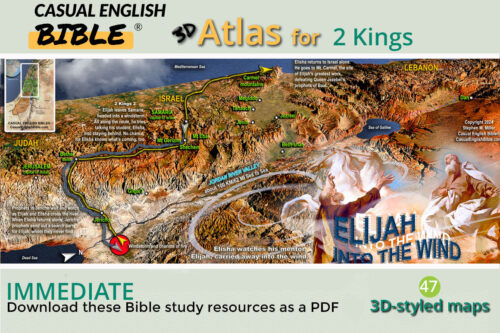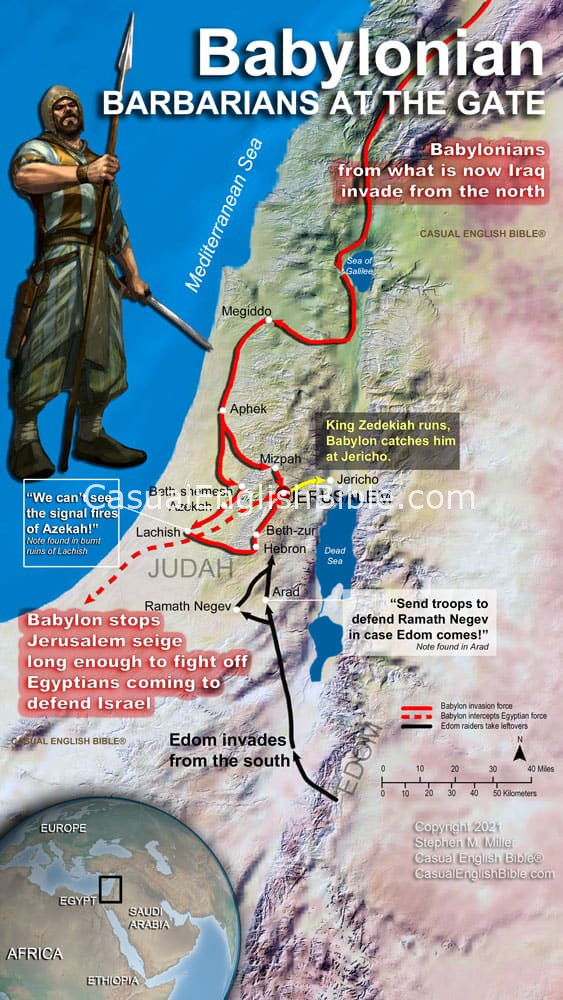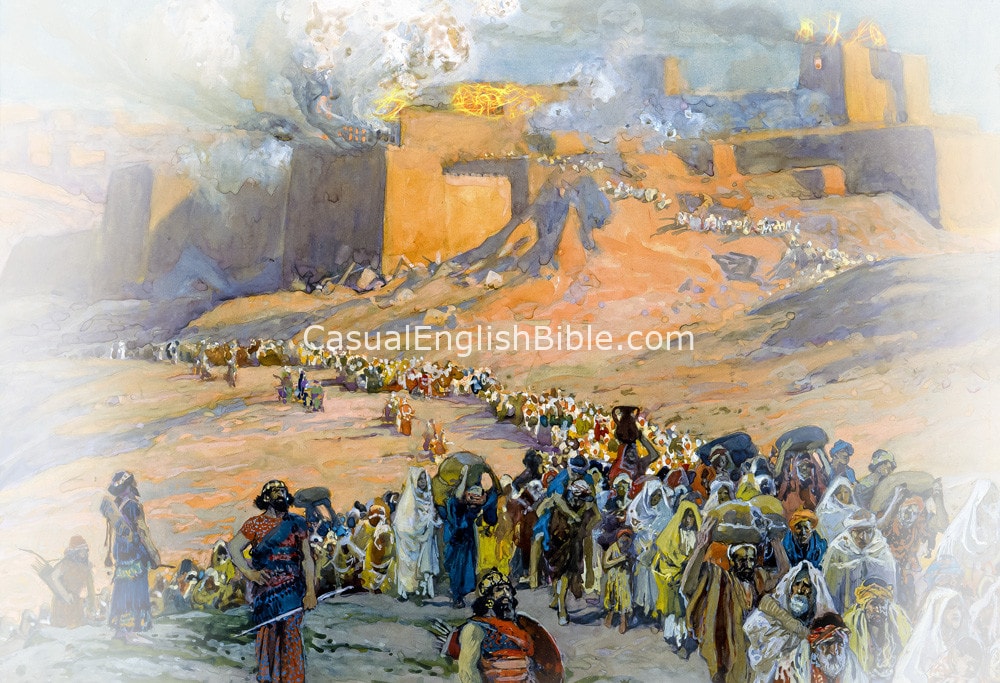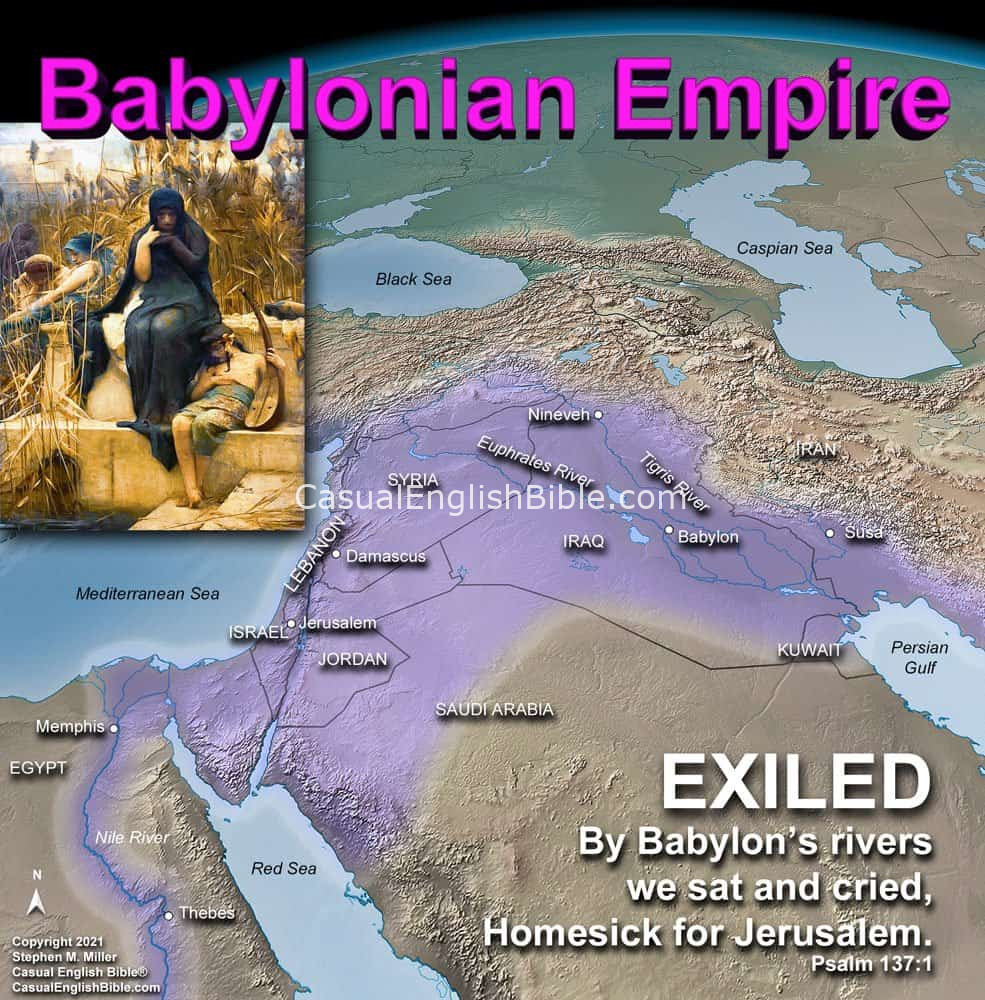2 Kings 25
End of the Jewish nation
Judah bows to Babylon
2 Chronicles 36:17-21; Jeremiah 52:3-30 1For a third time, Babylon’s King Nebuchadnezzar comes to Jerusalem, but this time his soldiers lay siege to the city and begin to build siegeworks outside the city walls. 2This took place nine years into the reign of Judah’s King Zedekiah. [1]
3A year and a half later, in mid-July, people of Jerusalem had eaten all the food. They were starving. 4That’s when Babylonians created a break in the wall. [2] The king and all his soldiers who had been defending the town ran for their lives. They escaped at night through the city gate near the King’s Garden. [3] They took the risk knowing Babylonians surrounded the city. Judah’s king and soldiers raced toward Jericho, in the Jordan River Valley. [4]
5Babylonians caught the king in the Jericho fields. [5] His soldiers scattered instead of defending him. 6Babylonian soldiers took King Zedekiah to Nebuchadnezzar, who had moved north to the Syrian town of Riblah. Babylon’s king pronounced sentence. 7As ordered, Babylonian soldiers slaughtered Zedekiah’s sons right in front of him. Then they cut his eyes out of his head. They tied him up and shipped him off to Babylon. Jerusalem’s 400-year-old Temple, gone
8About a month later, in mid-August, [6] Babylon’s commander of the royal guards, Nebuzaradan, arrived in Jerusalem. By this time, Nebuchadnezzar was into his 19th year on Babylon’s throne.
9Nebuzaradan set Jerusalem’s Temple on fire. He torched all the houses in Jerusalem. Every big and beautiful house collapsed into ashes. 10Then all the soldiers along with Nebuzaradan, began tearing down the walls of Jerusalem.
11When he and the guards later left for Babylon, they took with them Jerusalem’s survivors and deserters—escorting them into exile. 12But the commander left the poorest people behind to take care of the farms and vineyards. Babylon strips bronze from the Temple
13Babylonians stripped the bronze from the Temple, breaking everything into pieces to make it easier to carry it home. They broke apart the pillars at the Temple entrance and the huge bowl—a water reservoir called the Sea, [7] along with its stands. Priests used water from the Sea for sacrifices at the altar. 14They took all the bronze from inside the Temple, too: incense bowls, pots, shovels, lamp snuffers that priests had used to put out the lamplights. If it was bronze and in the Temple, they took it. 15They even took the small firepans that held hot coals and the small bowls for water. The commander told them to take everything of value and to make sure they got all the gold and silver.
16There was too much bronze to weigh. They took the two huge pillars from the Temple entrance, the huge water basin called the Sea, and the stands that held it. Solomon had it all made for the LORD’s Temple. 17Each pillar stood 27 feet tall, topped with bronze capitals more than seven feet tall. [8] The capitals were decorated with rows of pomegranate art and with a latticework design that looked like seven chains woven into the form of nets. Babylon executes Jerusalem priests
18Commander of the Guard Nebuzaradan arrested some Temple priests:
- High Priest Seraiah
- Top associate priest, Zephaniah
- Three Temple guards.
19He also arrested groups of people still hiding in the city:
- One army commander
- Five personal advisors to the king
- One scribe, an official who took notes
- One commander in charge of recruiting Judah’s militia
- Sixty soldiers.
20Nebuzaradan took them to the Babylonian king at Riblah, near Hamath. 21The king killed them all. And Judah was gone—scattered in exile. Judah gets a Babylon-appointed governor
Jeremiah 40:7-9; 41:1-3 22Babylon’s king appointed Gedaliah governor over those left behind in Judah. Gedaliah was the son of Ahikam and the grandson of Shaphan.
23Scattered units of Judah’s soldiers who didn’t get caught heard about Gedaliah’s appointment. Some went to meet him at the town where he set up office, Mizpah. [9] The men [10] were:
- Ishmael, the son of Nethaniah
- Johanan, the son of Kareah
- Seraiah, the son of Tanhumeth from the town of Netophah [11]
- Jaazaniah from Maacah.
24Gedaliah tried to reassure the men. He said, “Gentlemen, I promise you we’ll be okay. We don’t need to be afraid of the Babylonians anymore. If we live peacefully in the land and do what the Babylonian king says, things will get better again.”
25A couple months later, some men went to Mizpah and assassinated Governor Gedaliah and the people with him. The killers were Ishmael, the son of Nethaniah, along with Elishama, a member of the royal family. They brought 10 other men with them. The squad of assassins killed Gedaliah’s guests, which included Babylonians and people of Judah.
26That started a panic. People left the country, for Egypt. Military commanders, people important, and other people just trying to survive—they all left. They were afraid of what the Babylonians would do to them. A blind king of Judah free in Babylon
Jeremiah 52:31-34 27Jehoiachin, former king of Judah, served 37 years in a Babylonian prison. [12] A new Babylonian king named Evil-Merodach kindly freed him during the first year of his reign, sometime in February or March. [13] 28King Evil-Merodach took a liking to the old Jewish king. He talked warmly with him and showed him more respect than he did the other conquered kings in Babylon.
29Jehoiachin traded in his prison clothes for something more presentable. And every day for the rest of his life, he ate with the king. 30The Babylonian king even gave him a pension to cover his expenses for the rest of his life. Footnotes
125:2Jeremiah’s version of the story adds that the Babylonians arrived in the dead of winter, on the tenth day of the tenth month on the Jewish calendar. Scholars put the invasion in late December or early January, possibly in 588-587 BC. Most scholars seem to say the siege lasted a year and a half, from the winter of 588-587 BC to the July heat of 586 BC (some lobby for a year earlier on both dates).
225:4Soldiers attacked the walls in different ways, looking for the weakest point to attack. They would plow into it with a large battering ram. They would build catapults to throw stone missiles at Jerusalem’s walls, which were built with massive blocks of cut rock. Attackers also used men called sappers. They would dig a short tunnel under part of the wall. They would brace it with beams. Then they pulled down the beams, which would collapse the tunnel and possibly a part of the wall above the tunnel.
325:4Maybe the king and his men escaped through this gate. Or maybe the Babylonians broke into the city through this gate. The verse is confusing, which leaves scholars and Bible translators guessing and possibly flipping coins.
425:4Also known as the Arabah, a rift valley north and south of the Dead Sea.
525:5Jericho was about 20 winding, downhill miles (33 km) from Jerusalem.
625:8Literally, on the “seventh day of the fifth month” on the Jewish lunar calendar.
725:13For a more detailed description of the metals in the Temple, see 1 Kings 6—7.
825:17The pillars were eight meters tall, with another two meters for the crown.
925:23Scholars link Mizpah to a ruin called Tell en Nasbeh, just a few miles north of Jerusalem. Archaeologists say the area shows no evidence of getting burned out when Jerusalem fell. It was apparently one of the cities Babylon spared.
1025:23The men are unknowns, but their names seem were common at that time in history.
1125:23Netophah was likely near Bethlehem. Second Samuel lists it with cities in that area (23:24-28).
1225:27Arrested at about age 18, he would have been about 55 years old when the Babylonian king freed him.
1325:27Literally, on the “27th day of the 12th month” on the Jewish calendar.
Discussion Questions
- Sorry, there are currently no questions for this chapter.
Videos
3A year and a half later, in mid-July, people of Jerusalem had eaten all the food. They were starving. 4That’s when Babylonians created a break in the wall. [2] The king and all his soldiers who had been defending the town ran for their lives. They escaped at night through the city gate near the King’s Garden. [3] They took the risk knowing Babylonians surrounded the city. Judah’s king and soldiers raced toward Jericho, in the Jordan River Valley. [4]
5Babylonians caught the king in the Jericho fields. [5] His soldiers scattered instead of defending him. 6Babylonian soldiers took King Zedekiah to Nebuchadnezzar, who had moved north to the Syrian town of Riblah. Babylon’s king pronounced sentence. 7As ordered, Babylonian soldiers slaughtered Zedekiah’s sons right in front of him. Then they cut his eyes out of his head. They tied him up and shipped him off to Babylon.
Jerusalem’s 400-year-old Temple, gone
8About a month later, in mid-August, [6] Babylon’s commander of the royal guards, Nebuzaradan, arrived in Jerusalem. By this time, Nebuchadnezzar was into his 19th year on Babylon’s throne.9Nebuzaradan set Jerusalem’s Temple on fire. He torched all the houses in Jerusalem. Every big and beautiful house collapsed into ashes. 10Then all the soldiers along with Nebuzaradan, began tearing down the walls of Jerusalem.
11When he and the guards later left for Babylon, they took with them Jerusalem’s survivors and deserters—escorting them into exile. 12But the commander left the poorest people behind to take care of the farms and vineyards.
Babylon strips bronze from the Temple
13Babylonians stripped the bronze from the Temple, breaking everything into pieces to make it easier to carry it home. They broke apart the pillars at the Temple entrance and the huge bowl—a water reservoir called the Sea, [7] along with its stands. Priests used water from the Sea for sacrifices at the altar. 14They took all the bronze from inside the Temple, too: incense bowls, pots, shovels, lamp snuffers that priests had used to put out the lamplights. If it was bronze and in the Temple, they took it. 15They even took the small firepans that held hot coals and the small bowls for water. The commander told them to take everything of value and to make sure they got all the gold and silver.16There was too much bronze to weigh. They took the two huge pillars from the Temple entrance, the huge water basin called the Sea, and the stands that held it. Solomon had it all made for the LORD’s Temple. 17Each pillar stood 27 feet tall, topped with bronze capitals more than seven feet tall. [8] The capitals were decorated with rows of pomegranate art and with a latticework design that looked like seven chains woven into the form of nets.
Babylon executes Jerusalem priests
18Commander of the Guard Nebuzaradan arrested some Temple priests:- High Priest Seraiah
- Top associate priest, Zephaniah
- Three Temple guards.
- One army commander
- Five personal advisors to the king
- One scribe, an official who took notes
- One commander in charge of recruiting Judah’s militia
- Sixty soldiers.
Judah gets a Babylon-appointed governor
Jeremiah 40:7-9; 41:1-3 22Babylon’s king appointed Gedaliah governor over those left behind in Judah. Gedaliah was the son of Ahikam and the grandson of Shaphan.
23Scattered units of Judah’s soldiers who didn’t get caught heard about Gedaliah’s appointment. Some went to meet him at the town where he set up office, Mizpah. [9] The men [10] were:
- Ishmael, the son of Nethaniah
- Johanan, the son of Kareah
- Seraiah, the son of Tanhumeth from the town of Netophah [11]
- Jaazaniah from Maacah.
24Gedaliah tried to reassure the men. He said, “Gentlemen, I promise you we’ll be okay. We don’t need to be afraid of the Babylonians anymore. If we live peacefully in the land and do what the Babylonian king says, things will get better again.”
25A couple months later, some men went to Mizpah and assassinated Governor Gedaliah and the people with him. The killers were Ishmael, the son of Nethaniah, along with Elishama, a member of the royal family. They brought 10 other men with them. The squad of assassins killed Gedaliah’s guests, which included Babylonians and people of Judah.
26That started a panic. People left the country, for Egypt. Military commanders, people important, and other people just trying to survive—they all left. They were afraid of what the Babylonians would do to them. A blind king of Judah free in Babylon
Jeremiah 52:31-34 27Jehoiachin, former king of Judah, served 37 years in a Babylonian prison. [12] A new Babylonian king named Evil-Merodach kindly freed him during the first year of his reign, sometime in February or March. [13] 28King Evil-Merodach took a liking to the old Jewish king. He talked warmly with him and showed him more respect than he did the other conquered kings in Babylon.
29Jehoiachin traded in his prison clothes for something more presentable. And every day for the rest of his life, he ate with the king. 30The Babylonian king even gave him a pension to cover his expenses for the rest of his life. Footnotes
125:2Jeremiah’s version of the story adds that the Babylonians arrived in the dead of winter, on the tenth day of the tenth month on the Jewish calendar. Scholars put the invasion in late December or early January, possibly in 588-587 BC. Most scholars seem to say the siege lasted a year and a half, from the winter of 588-587 BC to the July heat of 586 BC (some lobby for a year earlier on both dates).
225:4Soldiers attacked the walls in different ways, looking for the weakest point to attack. They would plow into it with a large battering ram. They would build catapults to throw stone missiles at Jerusalem’s walls, which were built with massive blocks of cut rock. Attackers also used men called sappers. They would dig a short tunnel under part of the wall. They would brace it with beams. Then they pulled down the beams, which would collapse the tunnel and possibly a part of the wall above the tunnel.
325:4Maybe the king and his men escaped through this gate. Or maybe the Babylonians broke into the city through this gate. The verse is confusing, which leaves scholars and Bible translators guessing and possibly flipping coins.
425:4Also known as the Arabah, a rift valley north and south of the Dead Sea.
525:5Jericho was about 20 winding, downhill miles (33 km) from Jerusalem.
625:8Literally, on the “seventh day of the fifth month” on the Jewish lunar calendar.
725:13For a more detailed description of the metals in the Temple, see 1 Kings 6—7.
825:17The pillars were eight meters tall, with another two meters for the crown.
925:23Scholars link Mizpah to a ruin called Tell en Nasbeh, just a few miles north of Jerusalem. Archaeologists say the area shows no evidence of getting burned out when Jerusalem fell. It was apparently one of the cities Babylon spared.
1025:23The men are unknowns, but their names seem were common at that time in history.
1125:23Netophah was likely near Bethlehem. Second Samuel lists it with cities in that area (23:24-28).
1225:27Arrested at about age 18, he would have been about 55 years old when the Babylonian king freed him.
1325:27Literally, on the “27th day of the 12th month” on the Jewish calendar.
Discussion Questions
- Sorry, there are currently no questions for this chapter.
Videos
23Scattered units of Judah’s soldiers who didn’t get caught heard about Gedaliah’s appointment. Some went to meet him at the town where he set up office, Mizpah. [9] The men [10] were:
- Ishmael, the son of Nethaniah
- Johanan, the son of Kareah
- Seraiah, the son of Tanhumeth from the town of Netophah [11]
- Jaazaniah from Maacah.
25A couple months later, some men went to Mizpah and assassinated Governor Gedaliah and the people with him. The killers were Ishmael, the son of Nethaniah, along with Elishama, a member of the royal family. They brought 10 other men with them. The squad of assassins killed Gedaliah’s guests, which included Babylonians and people of Judah.
26That started a panic. People left the country, for Egypt. Military commanders, people important, and other people just trying to survive—they all left. They were afraid of what the Babylonians would do to them.
A blind king of Judah free in Babylon
Jeremiah 52:31-34 27Jehoiachin, former king of Judah, served 37 years in a Babylonian prison. [12] A new Babylonian king named Evil-Merodach kindly freed him during the first year of his reign, sometime in February or March. [13] 28King Evil-Merodach took a liking to the old Jewish king. He talked warmly with him and showed him more respect than he did the other conquered kings in Babylon.
29Jehoiachin traded in his prison clothes for something more presentable. And every day for the rest of his life, he ate with the king. 30The Babylonian king even gave him a pension to cover his expenses for the rest of his life. Footnotes
125:2Jeremiah’s version of the story adds that the Babylonians arrived in the dead of winter, on the tenth day of the tenth month on the Jewish calendar. Scholars put the invasion in late December or early January, possibly in 588-587 BC. Most scholars seem to say the siege lasted a year and a half, from the winter of 588-587 BC to the July heat of 586 BC (some lobby for a year earlier on both dates).
225:4Soldiers attacked the walls in different ways, looking for the weakest point to attack. They would plow into it with a large battering ram. They would build catapults to throw stone missiles at Jerusalem’s walls, which were built with massive blocks of cut rock. Attackers also used men called sappers. They would dig a short tunnel under part of the wall. They would brace it with beams. Then they pulled down the beams, which would collapse the tunnel and possibly a part of the wall above the tunnel.
325:4Maybe the king and his men escaped through this gate. Or maybe the Babylonians broke into the city through this gate. The verse is confusing, which leaves scholars and Bible translators guessing and possibly flipping coins.
425:4Also known as the Arabah, a rift valley north and south of the Dead Sea.
525:5Jericho was about 20 winding, downhill miles (33 km) from Jerusalem.
625:8Literally, on the “seventh day of the fifth month” on the Jewish lunar calendar.
725:13For a more detailed description of the metals in the Temple, see 1 Kings 6—7.
825:17The pillars were eight meters tall, with another two meters for the crown.
925:23Scholars link Mizpah to a ruin called Tell en Nasbeh, just a few miles north of Jerusalem. Archaeologists say the area shows no evidence of getting burned out when Jerusalem fell. It was apparently one of the cities Babylon spared.
1025:23The men are unknowns, but their names seem were common at that time in history.
1125:23Netophah was likely near Bethlehem. Second Samuel lists it with cities in that area (23:24-28).
1225:27Arrested at about age 18, he would have been about 55 years old when the Babylonian king freed him.
1325:27Literally, on the “27th day of the 12th month” on the Jewish calendar.
Discussion Questions
- Sorry, there are currently no questions for this chapter.
Videos
29Jehoiachin traded in his prison clothes for something more presentable. And every day for the rest of his life, he ate with the king. 30The Babylonian king even gave him a pension to cover his expenses for the rest of his life.
Footnotes
Jeremiah’s version of the story adds that the Babylonians arrived in the dead of winter, on the tenth day of the tenth month on the Jewish calendar. Scholars put the invasion in late December or early January, possibly in 588-587 BC. Most scholars seem to say the siege lasted a year and a half, from the winter of 588-587 BC to the July heat of 586 BC (some lobby for a year earlier on both dates).
Soldiers attacked the walls in different ways, looking for the weakest point to attack. They would plow into it with a large battering ram. They would build catapults to throw stone missiles at Jerusalem’s walls, which were built with massive blocks of cut rock. Attackers also used men called sappers. They would dig a short tunnel under part of the wall. They would brace it with beams. Then they pulled down the beams, which would collapse the tunnel and possibly a part of the wall above the tunnel.
Maybe the king and his men escaped through this gate. Or maybe the Babylonians broke into the city through this gate. The verse is confusing, which leaves scholars and Bible translators guessing and possibly flipping coins.
Also known as the Arabah, a rift valley north and south of the Dead Sea.
Jericho was about 20 winding, downhill miles (33 km) from Jerusalem.
Literally, on the “seventh day of the fifth month” on the Jewish lunar calendar.
For a more detailed description of the metals in the Temple, see 1 Kings 6—7.
The pillars were eight meters tall, with another two meters for the crown.
Scholars link Mizpah to a ruin called Tell en Nasbeh, just a few miles north of Jerusalem. Archaeologists say the area shows no evidence of getting burned out when Jerusalem fell. It was apparently one of the cities Babylon spared.
The men are unknowns, but their names seem were common at that time in history.
Netophah was likely near Bethlehem. Second Samuel lists it with cities in that area (23:24-28).
Arrested at about age 18, he would have been about 55 years old when the Babylonian king freed him.
Literally, on the “27th day of the 12th month” on the Jewish calendar.
Discussion Questions
- Sorry, there are currently no questions for this chapter.








